Reddening-Free Q Parameters to Classify B-Type Stars with Emission Lines
Abstract
:1. Introduction
2. Reddening-Free Q Parameter
3. Study of Gaia and 2MASS Reddening-Free Q Parameters
3.1. The Q Parameters and Color-Color Diagrams for Normal B-Type Stars
3.2. The Q–Color and Q–Q Diagrams for Normal B-Type Stars
4. B-Type Stars with Emission Lines
4.1. Color–Color Diagrams for Emission-Line B-Type Stars
4.2. Q–Color and Q–Q Diagrams for Emission-Line B-Type Stars
5. Discussion
6. Conclusions
Author Contributions
Funding
Data Availability Statement
Acknowledgments
Conflicts of Interest
Abbreviations
| CE | Circumstellar envelope |
| IR | infrared |
| HAeBe | Herbig Ae/Be star |
| PMS | Pre-main sequence star |
| CBe | Classical Be star |
| BSG | B supergiant star |
| LBV | Luminous Blue Variable star |
| B[e]SG | B[e] supergiant star |
| unclB[e] | unclassified B[e] star |
| NIR | near infrared |
| CCD | Color-color diagram |
| YSO | Young Stellar Object |
| Gaia | Global Astrometric Interferometer for Astrophysics mission |
| 2MASS | Two Micron All Sky Survey |
| QQD | Q-Q diagrams |
| EDR3 | Early Data Release 3 |
| QCD | Q-color index diagram |
| ISM | Interstellar medium |
| Effective temperature | |
| Topcat | Tool for OPerations on Catalogues And Tables |
| MS | Main sequence |
| 1 | The color-excess ratio is where and are the relative absorption coefficients referring to the color excess , , and to the extinction , , respectively. |
| 2 | http://www.starlink.ac.uk/topcat/. The last accessed date is 2 January 2023. |
| 3 | https://extinction.readthedocs.io/en/latest/. The last accessed date was 2 January 2023. |
| 4 | Version 2019.3.22, in http://www.pas.rochester.edu/emamajek/EEM_dwarf_UBVIJHK_colors_Teff.txt. The last accessed date was 2 January 2023. |
References
- Porter, J.M.; Rivinius, T. Classical Be Stars. Publ. Astron. Soc. Pac. 2003, 115, 1153–1170. [Google Scholar] [CrossRef]
- Allen, D.A. Near infra-red magnitudes of 248 early-type emission-line stars and related objects. Mon. Not. R. Astron. Soc. 1973, 161, 145–166. [Google Scholar] [CrossRef] [Green Version]
- Herbig, G.H. The Spectra of Be- and Ae-Type Stars Associated with Nebulosity. Astrophys. J. Suppl. Ser. 1960, 4, 337. [Google Scholar] [CrossRef]
- Hillenbrand, L.A.; Strom, S.E.; Vrba, F.J.; Keene, J. Herbig Ae/Be Stars: Intermediate-Mass Stars Surrounded by Massive Circumstellar Accretion Disks. Astrophys. J. 1992, 397, 613. [Google Scholar] [CrossRef]
- Rivinius, T.; Carciofi, A.C.; Martayan, C. Classical Be stars. Rapidly rotating B stars with viscous Keplerian decretion disks. Astron. Astrophys. Rev. 2013, 21, 69. [Google Scholar] [CrossRef] [Green Version]
- Chita, S.M.; Langer, N.; van Marle, A.J.; García-Segura, G.; Heger, A. Multiple ring nebulae around blue supergiants. Astron. Astrophys. 2008, 488, L37–L41. [Google Scholar] [CrossRef] [Green Version]
- Lamers, H.J.G.L.M.; Zickgraf, F.J.; de Winter, D.; Houziaux, L.; Zorec, J. An improved classification of B[e]-type stars. Astron. Astrophys. 1998, 340, 117–128. [Google Scholar]
- Humphreys, R.M.; Davidson, K. The Luminous Blue Variables: Astrophysical Geysers. Publ. Astron. Soc. Pac. 1994, 106, 1025. [Google Scholar] [CrossRef]
- Mehner, A.; Baade, D.; Groh, J.H.; Rivinius, T.; Hambsch, F.J.; Bartlett, E.S.; Asmus, D.; Agliozzo, C.; Szeifert, T.; Stahl, O. Spectroscopic and photometric oscillatory envelope variability during the S Doradus outburst of the luminous blue variable R71. Astron. Astrophys. 2017, 608, A124. [Google Scholar] [CrossRef] [Green Version]
- Campagnolo, J.C.N.; Borges Fernandes, M.; Drake, N.A.; Kraus, M.; Guerrero, C.A.; Pereira, C.B. Detection of new eruptions in the Magellanic Clouds luminous blue variables R 40 and R 110. Astron. Astrophys. 2018, 613, A33. [Google Scholar] [CrossRef] [Green Version]
- Weis, K.; Bomans, D.J. Luminous Blue Variables. Galaxies 2020, 8, 20. [Google Scholar] [CrossRef]
- Kraus, M. A Census of B[e] Supergiants. Galaxies 2019, 7, 83. [Google Scholar] [CrossRef] [Green Version]
- Zickgraf, F.J.; Schulte-Ladbeck, R.E. Polarization characteristics of galactic Be stars. Astron. Astrophys. 1989, 214, 274–284. [Google Scholar]
- Miroshnichenko, A.S. Toward Understanding the B[e] Phenomenon. I. Definition of the Galactic FS CMa Stars. Astrophys. J. 2007, 667, 497–504. [Google Scholar] [CrossRef] [Green Version]
- Kwok, S. Proto-planetary nebulae. Annu. Rev. Astron. Astrophys. 1993, 31, 63–92. [Google Scholar] [CrossRef]
- Klement, R.; Carciofi, A.C.; Rivinius, T.; Matthews, L.D.; Vieira, R.G.; Ignace, R.; Bjorkman, J.E.; Mota, B.C.; Faes, D.M.; Bratcher, A.D.; et al. Revealing the structure of the outer disks of Be stars. Astron. Astrophys. 2017, 601, A74. [Google Scholar] [CrossRef] [Green Version]
- Oudmaijer, R.D. The B[e] Phenomenon in Pre-Main-Sequence Herbig Ae/Be Stars. In Proceedings of the The B[e] Phenomenon: Forty Years of Studies, Prague, Czech Republic, 27 June–1 July 2016; Miroshnichenko, A., Miroshnichenko, A., Zharikov, S., Korčáková, D., Wolf, M., Eds.; Astronomical Society of the Pacific Conference Series. Astronomical Society of the Pacific: California, CA, USA, 2017; Volume 508, p. 175. [Google Scholar]
- Sheikina, T.A.; Miroshnichenko, A.S.; Corporon, P. B-type Emission-line Stars with Warm Circumstellar Dust. In Proceedings of the IAU Colloq. 175: The Be Phenomenon in Early-Type Stars, Alicante, Spain, 28 June–2 July 1999; Smith, M.A., Henrichs, H.F., Fabregat, J., Eds.; Astronomical Society of the Pacific Conference Series. Astronomical Society of the Pacific: California, CA, USA, 2000; Volume 214, p. 494. [Google Scholar]
- Chen, P.S.; Shan, H.G.; Zhang, P. A new photometric study of Herbig Ae/Be stars in the infrared. New Astron. 2016, 44, 1–11. [Google Scholar] [CrossRef]
- Cidale, L.; Zorec, J.; Tringaniello, L. BCD spectrophotometry of stars with the B[e] phenomenon. I. Fundamental parameters. Astron. Astrophys. 2001, 368, 160–174. [Google Scholar] [CrossRef]
- Comerón, F.; Pasquali, A.; Rodighiero, G.; Stanishev, V.; De Filippis, E.; López Martí, B.; Gálvez Ortiz, M.C.; Stankov, A.; Gredel, R. On the massive star contents of Cygnus OB2. Astron. Astrophys. 2002, 389, 874–888. [Google Scholar] [CrossRef] [Green Version]
- Oksala, M.E.; Kraus, M.; Cidale, L.S.; Muratore, M.F.; Borges Fernandes, M. Probing the ejecta of evolved massive stars in transition. A VLT/SINFONI K-band survey. Astron. Astrophys. 2013, 558, A17. [Google Scholar] [CrossRef] [Green Version]
- Cochetti, Y.R.; Kraus, M.; Arias, M.L.; Cidale, L.S.; Eenmäe, T.; Liimets, T.; Torres, A.F.; Djupvik, A.A. Near-infrared Characterization of Four Massive Stars in Transition Phases. Astron. J. 2020, 160, 166. [Google Scholar] [CrossRef]
- Negueruela, I.; Schurch, M.P.E. A search for counterparts to massive X-ray binaries using photometric catalogues. Astron. Astrophys. 2007, 461, 631–639. [Google Scholar] [CrossRef]
- Johnson, H.L.; Morgan, W.W. Fundamental stellar photometry for standards of spectral type on the Revised System of the Yerkes Spectral Atlas. Astrophys. J. 1953, 117, 313. [Google Scholar] [CrossRef]
- Comerón, F.; Pasquali, A. The ionizing star of the North America and Pelican nebulae. Astron. Astrophys. 2005, 430, 541–548. [Google Scholar] [CrossRef] [Green Version]
- Bessell, M.S.; Brett, J.M. JHKLM Photometry: Standard Systems, Passbands, and Intrinsic Colors. Publ. Astron. Soc. Pac. 1988, 100, 1134. [Google Scholar] [CrossRef]
- Garcia, M.; Herrero, A.; Castro, N.; Corral, L.; Rosenberg, A. The young stellar population of IC 1613. II. Physical properties of OB associations. Astron. Astrophys. 2010, 523, A23. [Google Scholar] [CrossRef]
- Aparicio Villegas, T.; Alfaro, E.J.; Cabrera-Caño, J.; Moles, M.; Benítez, N.; Perea, J.; del Olmo, A.; Fernández-Soto, A.; Cristóbal-Hornillos, D.; Aguerri, J.A.L.; et al. Stellar physics with the ALHAMBRA photometric system. J. Phys. Conf. Ser. 2011, 328, 012004. [Google Scholar] [CrossRef]
- Gaia Collaboration; Prusti, T.; de Bruijne, J.H.J.; Brown, A.G.A.; Vallenari, A.; Babusiaux, C.; Bailer-Jones, C.A.L.; Bastian, U.; Biermann, M.; Evans, D.W.; et al. The Gaia mission. Astron. Astrophys. 2016, 595, A1. [Google Scholar] [CrossRef] [Green Version]
- Gaia Collaboration; Brown, A.G.A.; Vallenari, A.; Prusti, T.; de Bruijne, J.H.J.; Mignard, F.; Drimmel, R.; Babusiaux, C.; Bailer-Jones, C.A.L.; Bastian, U.; et al. Gaia Data Release 1. Summary of the astrometric, photometric, and survey properties. Astron. Astrophys. 2016, 595, A2. [Google Scholar] [CrossRef] [Green Version]
- Cutri, R.M.; Skrutskie, M.F.; van Dyk, S.; Beichman, C.A.; Carpenter, J.M.; Chester, T.; Cambresy, L.; Evans, T.; Fowler, J.; Gizis, J.; et al. 2MASS All Sky Catalog of Point Sources. 2003. Available online: https://vizier.cds.unistra.fr/viz-bin/VizieR?-source=II/246 (accessed on 2 January 2023).
- Skrutskie, M.F.; Cutri, R.M.; Stiening, R.; Weinberg, M.D.; Schneider, S.; Carpenter, J.M.; Beichman, C.; Capps, R.; Chester, T.; Elias, J.; et al. The Two Micron All Sky Survey (2MASS). Astron. J. 2006, 131, 1163–1183. [Google Scholar] [CrossRef]
- Straizys, V.; Lazauskaite, R.; Liubertas, R.; Azusienis, A. Star Classification Possibilities with Broad-Band Photometric Systems. I. The Sloan System. Balt. Astron. 1998, 7, 605–623. [Google Scholar] [CrossRef]
- Gaia Collaboration; Brown, A.G.A.; Vallenari, A.; Prusti, T.; de Bruijne, J.H.J.; Babusiaux, C.; Biermann, M.; Creevey, O.L.; Evans, D.W.; Eyer, L.; et al. Gaia Early Data Release 3. Summary of the contents and survey properties. Astron. Astrophys. 2021, 649, A1. [Google Scholar] [CrossRef]
- Johnson, H.L.; Morgan, W.W. Some Evidence for a Regional Variation in the Law of Interstellar Reddening. Astrophys. J. 1955, 122, 142. [Google Scholar] [CrossRef]
- Straižys, V. Multicolor Stellar Photometry; Pachart Pub. House: Tucson, AZ, USA, 1992. [Google Scholar]
- Bartkevicius, A.; Zdanavicius, K. Calculation of reddening-free parameters Q of the Vilnius photometric system by the iteration method. Vilnius Astron. Obs. Biul. 1975, 41, 30. [Google Scholar]
- Pucinskas, A. Photographic photometry of stars in the region of open cluster IC 4996 in the Vilnius photometric system. Vilnius Astron. Obs. Biul. 1982, 59, 3. [Google Scholar]
- Jasevicius, V. Photometric quantification of stars in the Vilnius system using the method of independent Q parameters. Vilnius Astron. Obs. Biul. 1986, 74, 40. [Google Scholar]
- Smriglio, F.; Boyle, R.P.; Straizys, V.; Janulis, R.; Nandy, K.; MacGillivray, H.T.; McLachlan, A.; Coluzzi, R.; Segato, C. Automated two-dimensional classification from multicolour photometry in the Vilnius system. Astron. Astrophys. 1986, 66, 181–190. [Google Scholar]
- Smriglio, F.; Dasgupta, A.K.; Nandy, K.; Boyle, R.P. A comparison of automated spectral classification using Vilnius photometry with MK classification. Astron. Astrophys. 1990, 228, 399–402. [Google Scholar]
- Jordi, C.; Gebran, M.; Carrasco, J.M.; de Bruijne, J.; Voss, H.; Fabricius, C.; Knude, J.; Vallenari, A.; Kohley, R.; Mora, A. Gaia broad band photometry. Astron. Astrophys. 2010, 523, A48. [Google Scholar] [CrossRef] [Green Version]
- Danielski, C.; Babusiaux, C.; Ruiz-Dern, L.; Sartoretti, P.; Arenou, F. The empirical Gaia G-band extinction coefficient. Astron. Astrophys. 2018, 614, A19. [Google Scholar] [CrossRef] [Green Version]
- Zorec, J.; Frémat, Y.; Cidale, L. On the evolutionary status of Be stars. I. Field Be stars near the Sun. Astron. Astrophys. 2005, 441, 235–248. [Google Scholar] [CrossRef] [Green Version]
- Zorec, J.; Cidale, L.; Arias, M.L.; Frémat, Y.; Muratore, M.F.; Torres, A.F.; Martayan, C. Fundamental parameters of B supergiants from the BCD system. I. Calibration of the (λ_1, D) parameters into Teff. Astron. Astrophys. 2009, 501, 297–320. [Google Scholar] [CrossRef] [Green Version]
- Aidelman, Y.; Cidale, L.S.; Zorec, J.; Arias, M.L. Open clusters. I. Fundamental parameters of B stars in NGC 3766 and NGC 4755. Astron. Astrophys. 2012, 544, A64. [Google Scholar] [CrossRef] [Green Version]
- Aidelman, Y.; Cidale, L.S.; Zorec, J.; Panei, J.A., II. Fundamental parameters of B stars in Collinder 223, Hogg 16, NGC 2645, NGC 3114, and NGC 6025. Astron. Astrophys. 2015, 577, A45. [Google Scholar] [CrossRef] [Green Version]
- Aidelman, Y.; Cidale, L.S.; Zorec, J.; Panei, J.A. Open clusters. III. Fundamental parameters of B stars in NGC 6087, NGC 6250, NGC 6383, and NGC 6530 B-type stars with circumstellar envelopes. Astron. Astrophys. 2018, 610, A30. [Google Scholar] [CrossRef] [Green Version]
- Cochetti, Y.R.; Zorec, J.; Cidale, L.S.; Arias, M.L.; Aidelman, Y.; Torres, A.F.; Frémat, Y.; Granada, A. Be and Bn stars: Balmer discontinuity and stellar-class relationship. Astron. Astrophys. 2020, 634, A18. [Google Scholar] [CrossRef]
- Barbier, D.; Chalonge, D. Étude du rayonnement continu de quelques étoiles entre 3 100 et 4 600 Å (4e Partie-discussion générale). Ann. D’Astrophys. 1941, 4, 30. [Google Scholar]
- Chalonge, D.; Divan, L. Recherches sur les spectres continus stellaires. V. Etude du spectre continu de 150 etoiles entre 3150 et 4600 A. Ann. D’Astrophys. 1952, 15, 201. [Google Scholar]
- Moujtahid, A.; Zorec, J.; Hubert, A.M.; Garcia, A.; Burki, G. Long-term visual spectrophotometric behaviour of Be stars. Astron. Astrophys. 1998, 129, 289–311. [Google Scholar] [CrossRef]
- Taylor, M.B. TOPCAT & STIL: Starlink Table/VOTable Processing Software. In Proceedings of the Astronomical Data Analysis Software and Systems XIV, San Francisco, CA, USA, 30 November 2005; Shopbell, P., Britton, M., Ebert, R., Eds.; Astronomical Society of the Pacific Conference Series. Astronomical Society of the Pacific: California, CA, USA, 2005; Volume 347, p. 29. [Google Scholar]
- Gabriel, C.; Arviset, C.; Ponz, D.; Enrique, S. Astronomical Society of the Pacific Conference Series. STILTS—A Package for Command-Line Processing of Tabular Data. In Proceedings of the Astronomical Data Analysis Software and Systems XV, San Francisco, CA, USA, 1 July 2006; Astronomical Society of the Pacific: California, CA, USA, 2006; Volume 351, p. 666. [Google Scholar]
- Barbary, K. Extinction v0.3.0; Zenodo: Les Ulis, France, 2016. [Google Scholar] [CrossRef]
- Cardelli, J.A.; Clayton, G.C.; Mathis, J.S. The Relationship between Infrared, Optical, and Ultraviolet Extinction. Astrophys. J. 1989, 345, 245. [Google Scholar] [CrossRef]
- O’Donnell, J.E. R v-dependent Optical and Near-Ultraviolet Extinction. Astrophys. J. 1994, 422, 158. [Google Scholar] [CrossRef]
- Fitzpatrick, E.L. Correcting for the Effects of Interstellar Extinction. Publ. Astron. Soc. Pac. 1999, 111, 63–75. [Google Scholar] [CrossRef] [Green Version]
- Fitzpatrick, E.L.; Massa, D. An Analysis of the Shapes of Interstellar Extinction Curves. V. The IR-through-UV Curve Morphology. Astrophys. J. 2007, 663, 320–341. [Google Scholar] [CrossRef] [Green Version]
- Pecaut, M.J.; Mamajek, E.E. Intrinsic Colors, Temperatures, and Bolometric Corrections of Pre-main-sequence Stars. Astrophys. J. Suppl. Ser. 2013, 208, 9. [Google Scholar] [CrossRef]
- Mucciarelli, A.; Bellazzini, M.; Massari, D. Exploiting the Gaia EDR3 photometry to derive stellar temperatures. Astron. Astrophys. 2021, 653, A90. [Google Scholar] [CrossRef]
- Poggio, E.; Drimmel, R.; Lattanzi, M.G.; Smart, R.L.; Spagna, A.; Andrae, R.; Bailer-Jones, C.A.L.; Fouesneau, M.; Antoja, T.; Babusiaux, C.; et al. The Galactic warp revealed by Gaia DR2 kinematics. Mon. Not. R. Astron. Soc. Lett. 2018, 481, L21–L25. [Google Scholar] [CrossRef]
- Clark, J.S.; Larionov, V.M.; Arkharov, A. On the population of galactic Luminous Blue Variables. Astron. Astrophys. 2005, 435, 239–246. [Google Scholar] [CrossRef] [Green Version]
- Guzmán-Díaz, J.; Mendigutía, I.; Montesinos, B.; Oudmaijer, R.D.; Vioque, M.; Rodrigo, C.; Solano, E.; Meeus, G.; Marcos-Arenal, P. Homogeneous study of Herbig Ae/Be stars from spectral energy distributions and Gaia EDR3. Astron. Astrophys. 2021, 650, A182. [Google Scholar] [CrossRef]
- Zhang, P.; Chen, P.S.; Yang, H.T. 2MASS observations of Be stars. New Astron. 2005, 10, 325–352. [Google Scholar] [CrossRef]
- Mohr-Smith, M.; Drew, J.E.; Napiwotzki, R.; Simón-Díaz, S.; Wright, N.J.; Barentsen, G.; Eislöffel, J.; Farnhill, H.J.; Greimel, R.; Monguió, M.; et al. The deep OB star population in Carina from the VST Photometric Hα Survey (VPHAS+). Mon. Not. R. Astron. Soc. Lett. 2017, 465, 1807–1830. [Google Scholar] [CrossRef] [Green Version]
- Mohr-Smith, M.; Drew, J.E.; Barentsen, G.; Wright, N.J.; Napiwotzki, R.; Corradi, R.L.M.; Eislöffel, J.; Groot, P.; Kalari, V.; Parker, Q.A.; et al. New OB star candidates in the Carina Arm around Westerlund 2 from VPHAS+. Mon. Not. R. Astron. Soc. Lett. 2015, 450, 3855–3873. [Google Scholar] [CrossRef] [Green Version]
- Lee, C.D.; Chen, W.P. Dust formation of Be stars with large infrared excess. In Proceedings of the Active OB Stars: Structure, Evolution, Mass Loss, and Critical Limits, Paris, France, 12–23 July 2010; Neiner, C., Wade, G., Meynet, G., Peters, G., Eds.; Cambridge University Press: Cambridge, UK, 2011; Volume 272, pp. 366–371. [Google Scholar] [CrossRef]
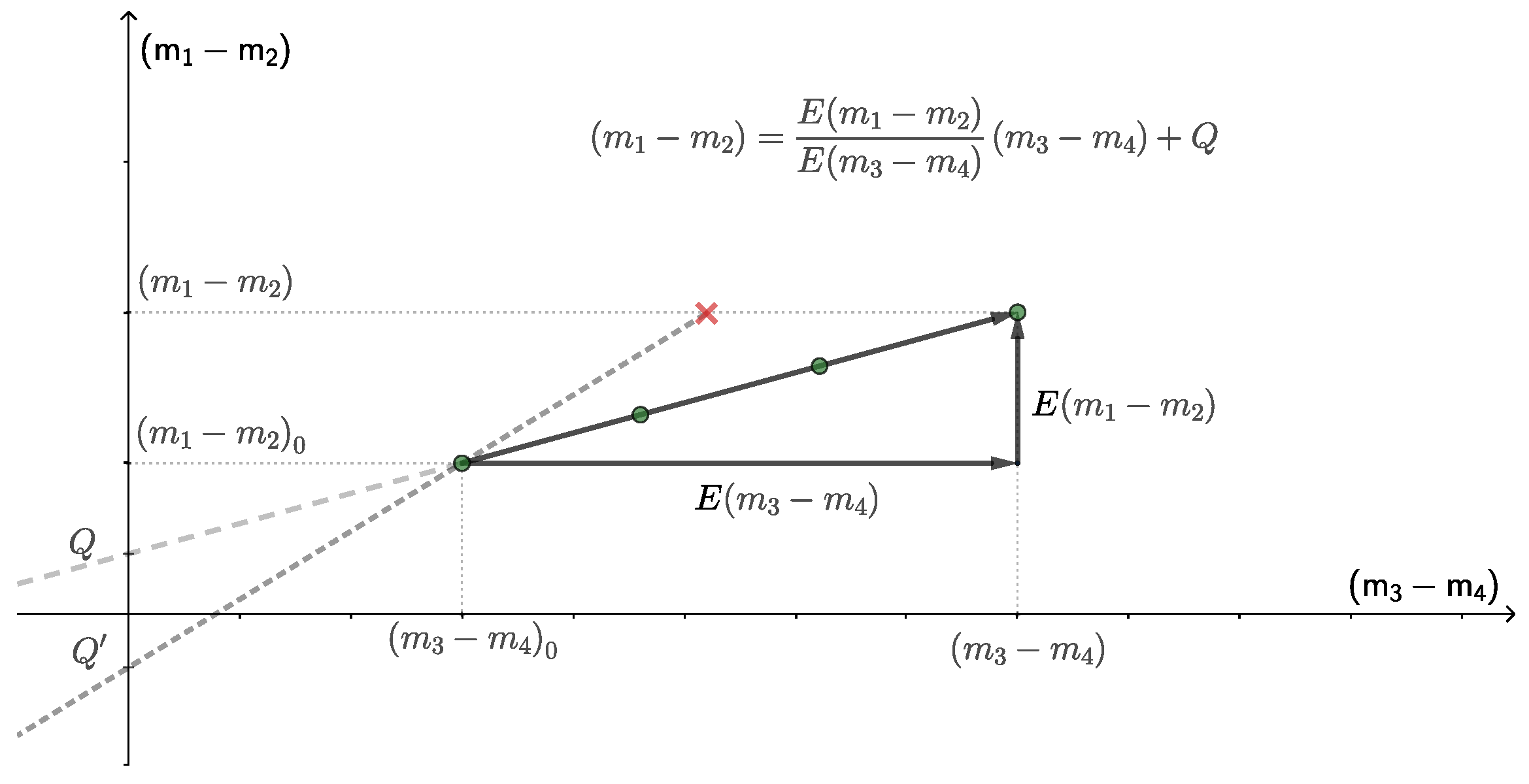

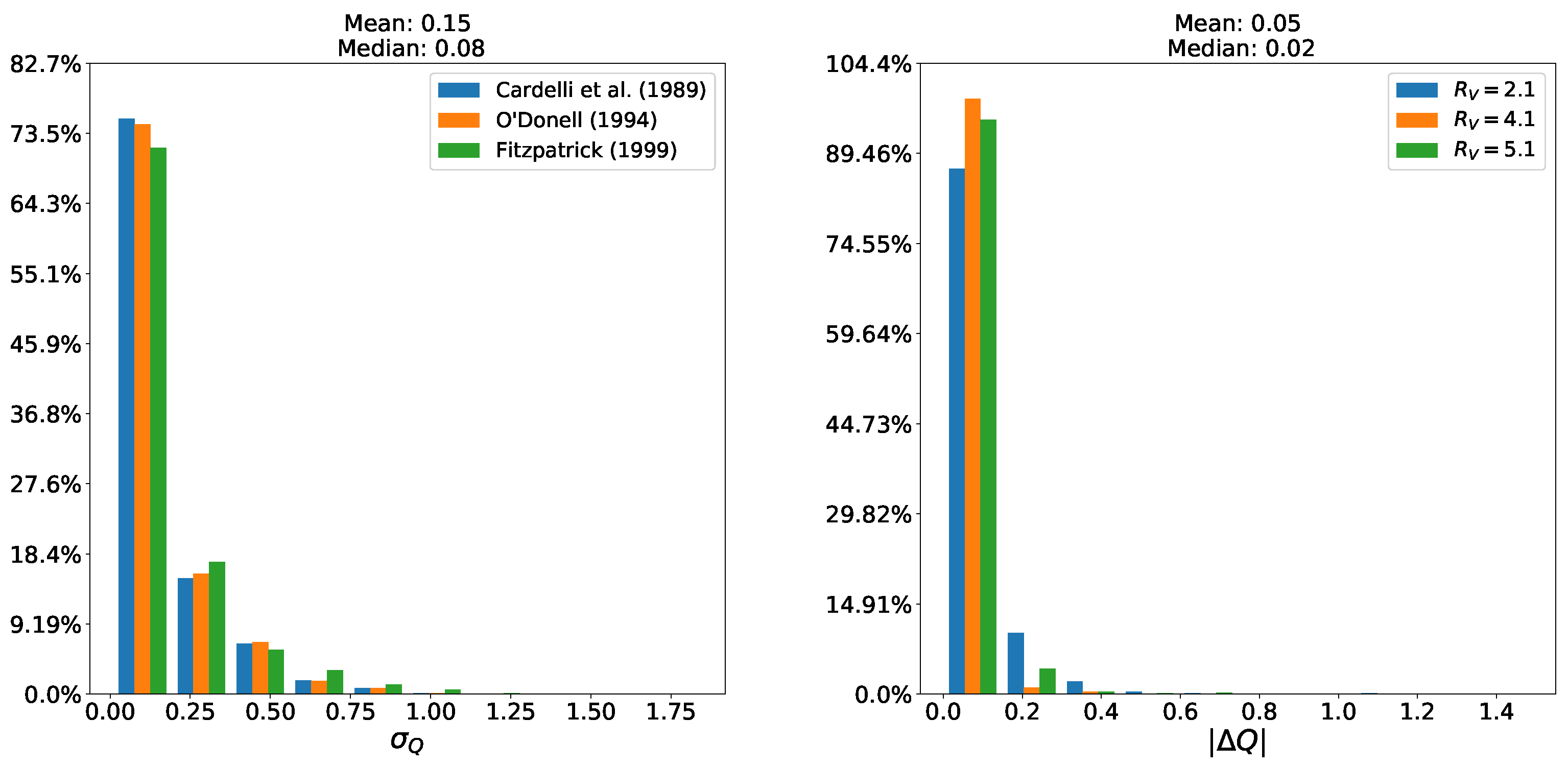
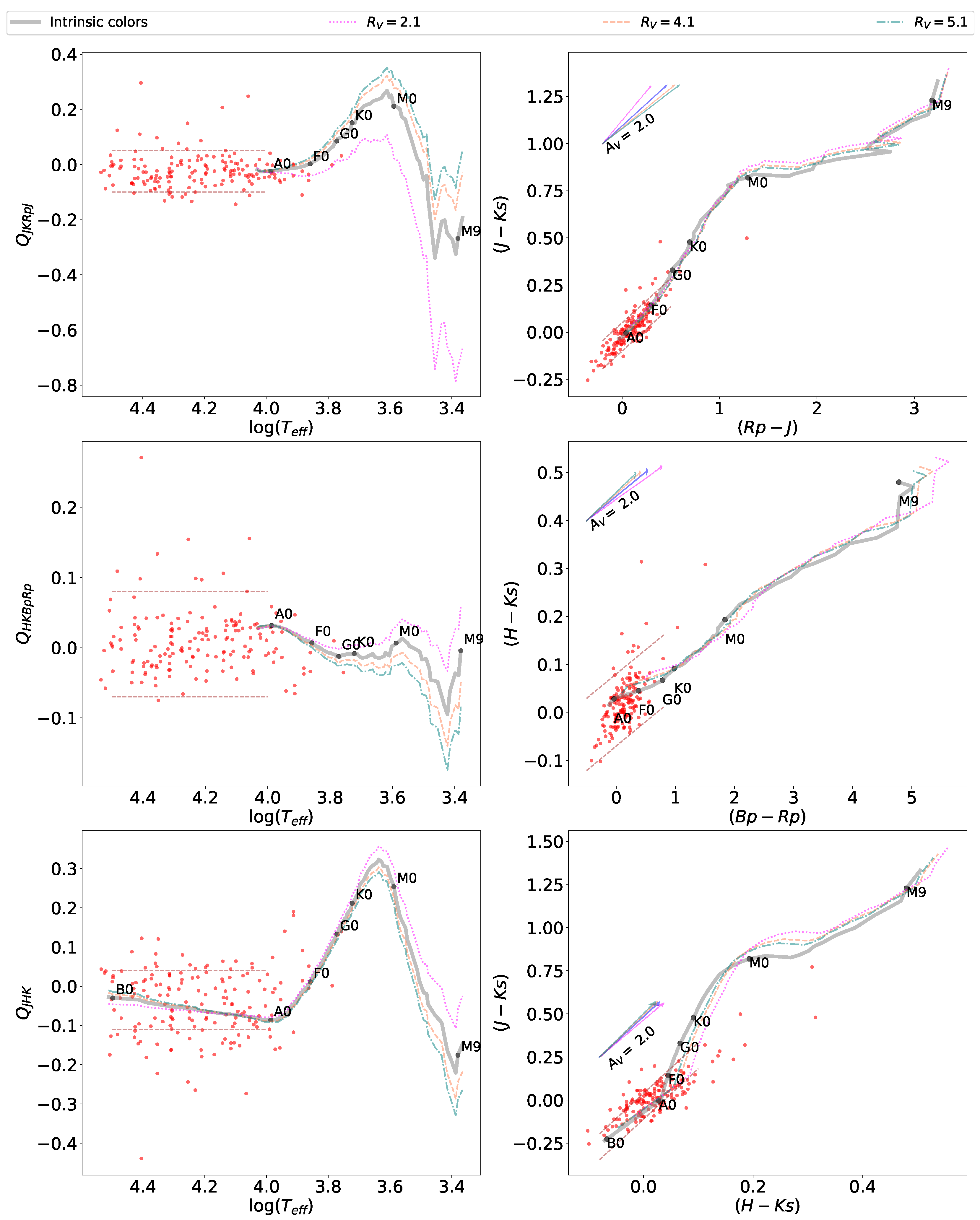

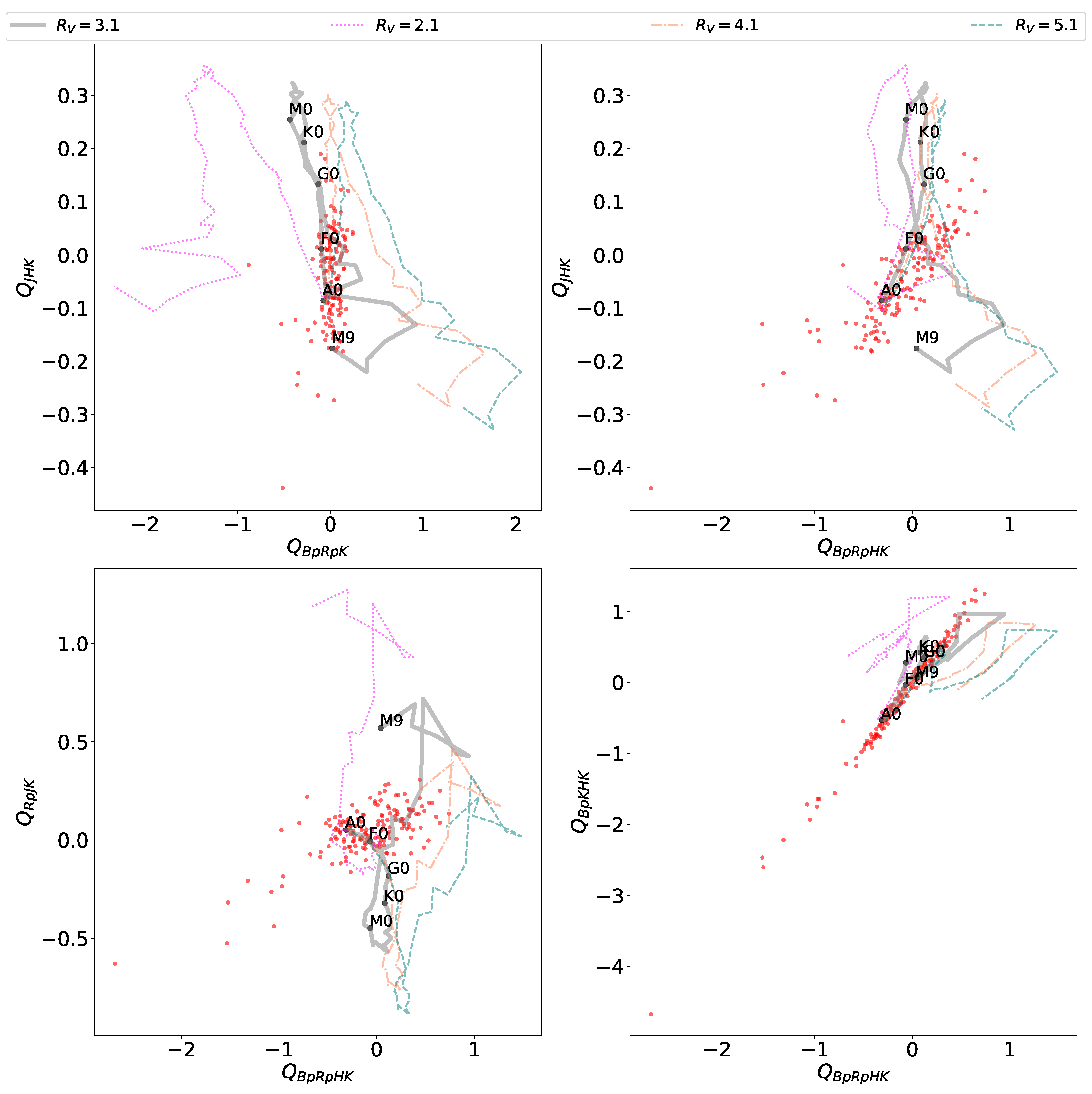

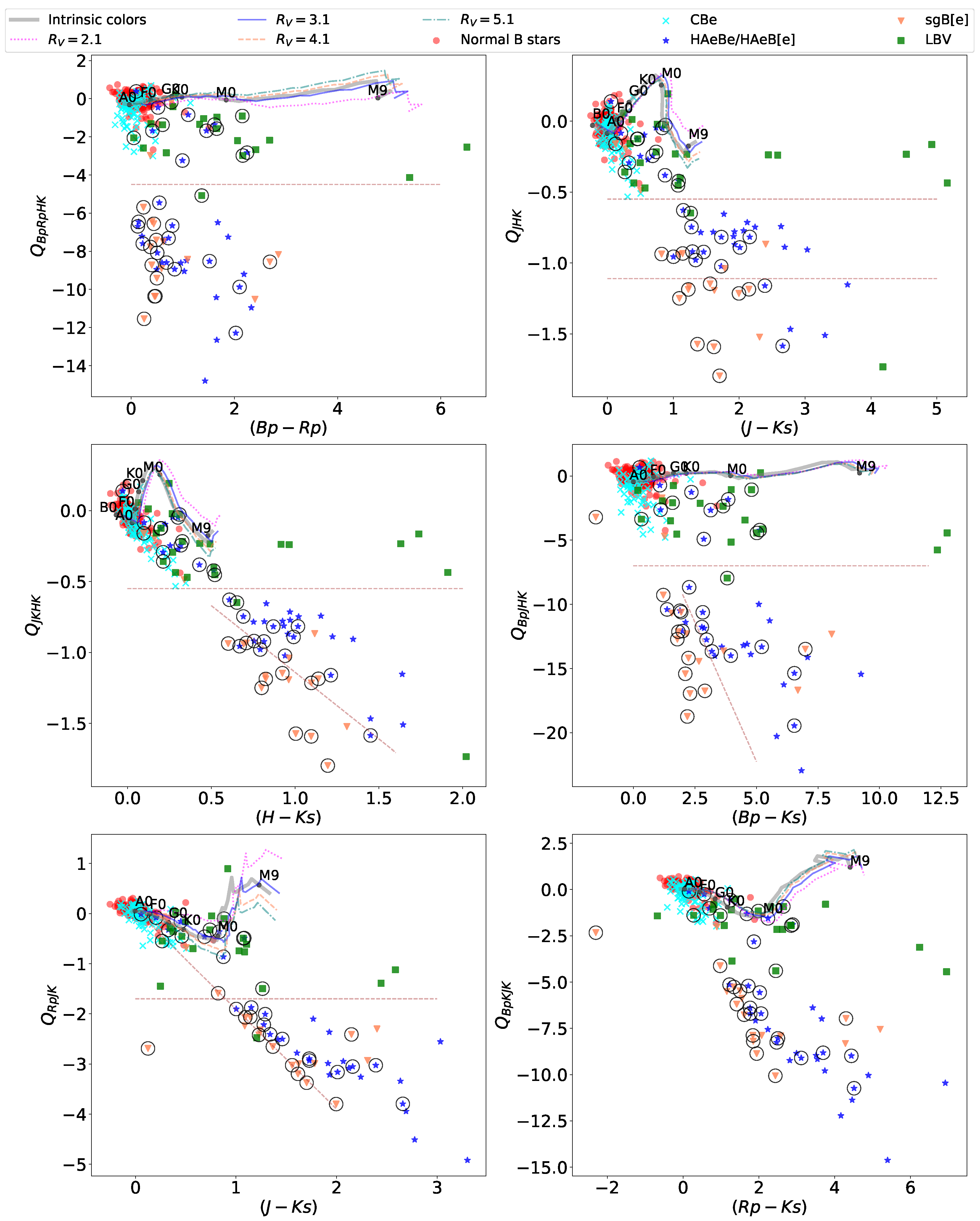
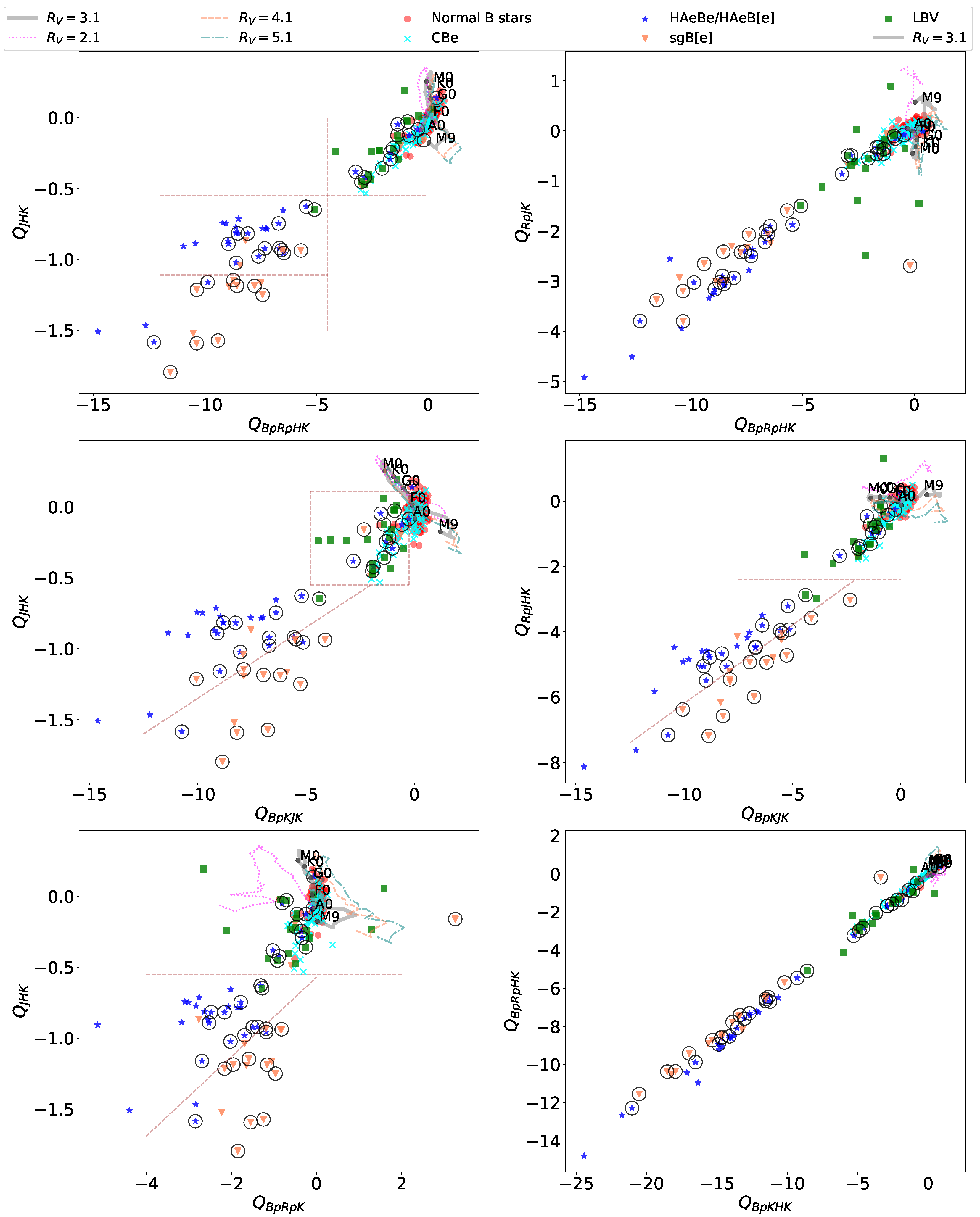
| Emission-Line B-Type Star | Evolutionary Stage |
|---|---|
| HAeB[e]/HAeBe | Pre-main sequence object with or without the B[e] phenomenon |
| CBe | Non-supergiant B-type star |
| LBV | Post-main sequence massive object |
| B[e]SG | B-supergiant star with the B[e] phenomenon |
| Filter | Central | ||||
|---|---|---|---|---|---|
| [Å] | |||||
| Cardelli et al. [57] | |||||
| Bp | 5110 | ||||
| Rp | 7770 | ||||
| J | 12,350 | ||||
| H | 16,620 | ||||
| Ks | 21,590 | ||||
| O’Donnell [58] | |||||
| Bp | 5110 | ||||
| Rp | 7770 | ||||
| J | 12,350 | ||||
| H | 16,620 | ||||
| Ks | 21,590 | ||||
| Fitzpatrick [59] | |||||
| Bp | 5110 | ||||
| Rp | 7770 | ||||
| J | 12,350 | ||||
| H | 16,620 | ||||
| Ks | 21,590 | ||||
| Normal B-Type Stars | |
|---|---|
| QD | |
| QCD | |
| QQD | |
| LBVs | |
| QCD | |
| QQD | |
| B[e]SGs | |
| QCD | |
| QQD | |
Disclaimer/Publisher’s Note: The statements, opinions and data contained in all publications are solely those of the individual author(s) and contributor(s) and not of MDPI and/or the editor(s). MDPI and/or the editor(s) disclaim responsibility for any injury to people or property resulting from any ideas, methods, instructions or products referred to in the content. |
© 2023 by the authors. Licensee MDPI, Basel, Switzerland. This article is an open access article distributed under the terms and conditions of the Creative Commons Attribution (CC BY) license (https://creativecommons.org/licenses/by/4.0/).
Share and Cite
Aidelman, Y.; Cidale, L.S. Reddening-Free Q Parameters to Classify B-Type Stars with Emission Lines. Galaxies 2023, 11, 31. https://doi.org/10.3390/galaxies11010031
Aidelman Y, Cidale LS. Reddening-Free Q Parameters to Classify B-Type Stars with Emission Lines. Galaxies. 2023; 11(1):31. https://doi.org/10.3390/galaxies11010031
Chicago/Turabian StyleAidelman, Yael, and Lydia Sonia Cidale. 2023. "Reddening-Free Q Parameters to Classify B-Type Stars with Emission Lines" Galaxies 11, no. 1: 31. https://doi.org/10.3390/galaxies11010031
APA StyleAidelman, Y., & Cidale, L. S. (2023). Reddening-Free Q Parameters to Classify B-Type Stars with Emission Lines. Galaxies, 11(1), 31. https://doi.org/10.3390/galaxies11010031






